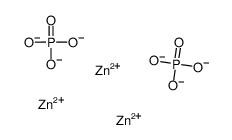7543-51-3
| Name | Zinc Phosphate Tetrahydrate |
|---|---|
| Synonyms | trizinc,diphosphate,tetrahydrate |
| Density | 3.04 g/cm3 |
|---|---|
| Molecular Formula | O8P2Zn3 |
| Molecular Weight | 386.08300 |
| Exact Mass | 381.69400 |
| PSA | 192.12000 |
| LogP | 0.76450 |
| Appearance | Powder | white |
| Water Solubility | insoluble H2O, alcohol; soluble dilute mineral acids, acetic acid, ammonia solutions, alkali hydroxide solutions [MER06] |
|
Section 1: Product Identification Chemical Name:Zinc phosphate hydrate CAS Registry Number:7543-51-3 Formula:Zn3(PO4)2.XH2O EINECS Number:none Chemical Family:metal phosphate compound Synonym:Zinc phosphate tetrahydrate, Phosphoric acid zinc salt tetrahydrate
Section 2: Composition and Information on Ingredients IngredientCAS NumberPercentACGIH (TWA)OSHA (PEL) Title Compound7543-51-3100%no datano data Section 3: Hazards Identification Emergency Overview:Irritating to eyes, skin and respiratory tract. Moderate amounts may be harmful if swallowed. Primary Routes of Exposure:Ingestion, inhalation Eye Contact:Causes slight to mild irritation of the eyes. Skin Contact:Causes slight to mild irritation of the skin. Inhalation:Irritating to the nose, mucous membranes and respiratory tract. Ingestion:May cause abdominal pain, nausea, and vomiting. Irritating to skin, eyes and respiratory tract. Inhalation of dust may cause burning sensation, coughing, Acute Health Affects: wheezing, laryngitis, shortness of breath, headache, nausea and vomiting. May be harmful if swallowed. Chronic Health Affects:Prolonged or repeated exposure may cause breathing difficulty and decreased pulmonary function. NTP:No IARC:No OSHA:No SECTION 4: First Aid Measures Immediately flush the eyes with copious amounts of water for at least 10-15 minutes. A victim may need Eye Exposure: assistance in keeping their eye lids open. Get immediate medical attention. Wash the affected area with water. Remove contaminated clothes if necessary. Seek medical assistance if Skin Exposure: irritation persists. Remove the victim to fresh air. Closely monitor the victim for signs of respiratory problems, such as difficulty Inhalation: in breathing, coughing, wheezing, or pain. In such cases seek immediate medical assistance. Seek medical attention immediately. Keep the victim calm. Give the victim water (only if conscious). Induce Ingestion: vomiting only if directed by medical personnel. SECTION 5: Fire Fighting Measures Flash Point:not applicable Autoignition Temperature:none Explosion Limits:none Extinguishing Medium:none required If involved in a fire, fire fighters should be equipped with a NIOSH approved positive pressure self-contained Special Fire Fighting Procedures: breathing apparatus and full protective clothing. Hazardous Combustion andNone Decomposion Products: Unusual Fire or Explosion Hazards: No unusual fire or explosion hazards. SECTION 6: Accidental Release Measures Spill and Leak Procedures:Small spills can be mixed with powdered sodium carbonate or ground limestone and swept up. SECTION 7: Handling and Storage Handling and Storage:Store material in a tightly sealed bottle away from moisture. SECTION 8: Exposure Controls and Personal Protection Eye Protection:Always wear approved safety glasses when handling a chemical substance in the laboratory. Skin Protection:Wear appropriate chemical resistant gloves and protective clothing. Ventilation:If possible, handle the material in an efficient fume hood. In the absence of adequate ventilation a respirator should be worn. The use of a respiratory requires a Respirator: Respirator Protection Program to be in compliance with 29 CFR 1910.134. Ventilation:If possible, handle the material in an efficient fume hood. Additional Protection:No additional protection required. SECTION 9: Physical and Chemical Properties Color and Form:white pwdr. Molecular Weight:386.05 Melting Point:no data Boiling Point:no data Vapor Pressure:no data Specific Gravity:3.04 Odor:none Solubility in Water:insoluble SECTION 10: Stability and Reactivity Stability:air and moisture stable Hazardous Polymerization:no hazardous polymerization Conditions to Avoid:none Incompatibility:Active metals Decomposition Products:none SECTION 11: Toxicological Information RTECS Data:No information available in the RTECS files. Carcinogenic Effects:no data Mutagenic Effects:no data Tetratogenic Effects:no data SECTION 12: Ecological Information Ecological Information:No information available SECTION 13: Disposal Considerations Disposal:Dispose of according to local, state and federal regulations. SECTION 14: Transportation Shipping Name (CFR):Non-hazardous Hazard Class (CFR):NA Additional Hazard Class (CFR):NA Packaging Group (CFR):NA UN ID Number (CFR):NA Shipping Name (IATA):Non-hazardous Hazard Class (IATA):NA Additional Hazard Class (IATA):NA Packaging Group (IATA):NA UN ID Number (IATA):NA SECTION 15: Regulatory Information TSCA:Not listed in the TSCA inventory. SARA (Title 313):Title compound: see category code N982 for reporting Second Ingredient:none SECTION 16 - ADDITIONAL INFORMATION N/A |
| Risk Phrases | R36/37/38 |
|---|---|
| Safety Phrases | 22-36/37/39 |
| HS Code | 2835299000 |
| HS Code | 2835299000 |
|---|
